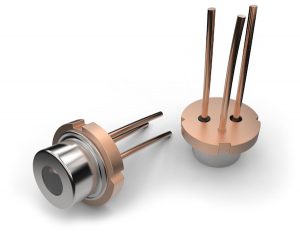Laser diode collimators are used to collimate the highly divergent beam that is emitted by a laser diode. It consists of a laser diode holder, a collimating lens holder, and a high numerical aperture (NA) collimating lens, with a focal length f. The lens is housed in a threaded receptacle that is screwed into the collimating lens holder. By adjusting the distance between the laser diode and the collimating lens, one can collimate the laser diode output.
There are several applications in which a laser diode collimator can be used, some of which are:
- Optical alignment systems
- Process control
- Medical processes
- Imaging systems
- Test and measurement
The dimensions of the collimated beam are determined by two factors – the far field divergence angles θ⊥ and θ||, of the laser diode being used, and the focal length of the collimating lens. The collimating beam dimensions are given by the equations BD⊥ = 2 × f × sin(θ⊥/2) BD|| = 2 × f × sin(θ||/2).
Laser diodes usually emit strongly diverging light, essentially because the meeting areas are typically rather small. For most applications, it is necessary to first transform the radiation into a collimated beam, using some kind of beam collimator. Because the properties of emission from various types of laser diodes can be quite different, different types of laser diode collimators have been developed.
For most laser diodes, the beam divergence is so substantial that it is advantageous to use aspheric lenses for beam collimation in order to avoid significant spherical aberrations of the collimated beam. To achieve the best performance, the numerical aperture of the lens should be significantly larger than that of the laser diode – for example: by a factor of two. On the other hand, the emission bandwidth is usually quite small, so that achromatic optics are not required in most cases.
There are different collimators that are available:
- Collimators for single-emitter laser diodes: Single-emitter laser diodes usually exhibit substantially different divergence in two orthogonal directions. In typical cases, one has about 10° divergence (full width at half maximum) in the “slow” direction and ≈30° in the “fast” direction.
- Collimators for VCSELs and VCSEL Arrays: It is relatively easy to collimate the output of a vertical cavity surface-emitting laser (VCSEL), since the output beam is usually circular and exhibits a quiet moderate beam divergence. A simple spherical lens with moderate numerical aperture is normally sufficient for that purpose. If the desired beam radius is relatively small, a micro lens may be employed.
- Collimators for Broad-area Emitters, Diode Bars and Diode Stacks: the emitting region of a broad-area laser diode is much larger in the direction along the wafer surface (often called the horizontal direction) than in the other one; this kind of laser design is chosen to obtain substantially higher output powers. The beam divergence in that “slow” direction is significantly smaller than in the fast direction, but by far not as small as it would be for a diffraction-limited beam: the emission is highly multimode in that direction. Therefore, the beam quality in that direction is far worse. A consequence of that is that while the beam diameter after a simple collimation lens is significantly smaller in the “slow” direction, the residual beam divergence in that direction is much larger.
Some broad-area emitters are sold with a fast axis collimation lens (FAC lens) fixed to the output facet. This collimate the output only in that direction, so that it is no more necessary to mount additional optical parts very close to the diode. The same technique can be applied to diode bars, e.g. packages containing multiple broad emitters in an array. A single cylindrical (or in fact slightly acylindrical) fast axis collimation lens (sometimes called a fiber lens) may be sufficient for all emitters. Problems can occur when such an emitter array exhibits a too large “smile”.
For diode stacks, one often uses an array of cylindrical micro lenses, each one working for one of the contained bars. In a larger distance, one may have a single cylindrical lens for collimating the beam in the slow direction.
High-power laser diodes are often equipped with collimators only for the fast direction. Slow axis collimation can be done with an additional lens.
We offer lens assemblies and elements that are available in standard combinations of focal lengths, wavelength, and barrel styles. We offer both glass and plastic aspheric designs to fill most typical application requirements. Our collimating lenses for diode lasers are ideal for a wide variety of instrumentation and gauging applications. Cylinder and rod lenses are available for beam sharpening, astigmatism correction, and line generation with diode lasers.
At Universe Optics, our comprehensive value-added and custom design lens capabilities will accommodate any non-standard design or manufacturing criteria.